Gall peters projection pros and cons – The Gall Peters projection, a unique map projection, has sparked both praise and criticism. This projection aims to represent landmasses in their true relative sizes, challenging traditional projections that distort certain regions. In this article, we delve into the advantages and disadvantages of the Gall Peters projection, examining its impact on education, cartography, and our understanding of global geography.
The Gall Peters projection, developed by Arno Peters in 1973, sought to create a more equitable and accurate representation of the world. It gained popularity in the 1980s and 1990s as a tool for promoting global awareness and challenging Eurocentric perspectives.
Introduction
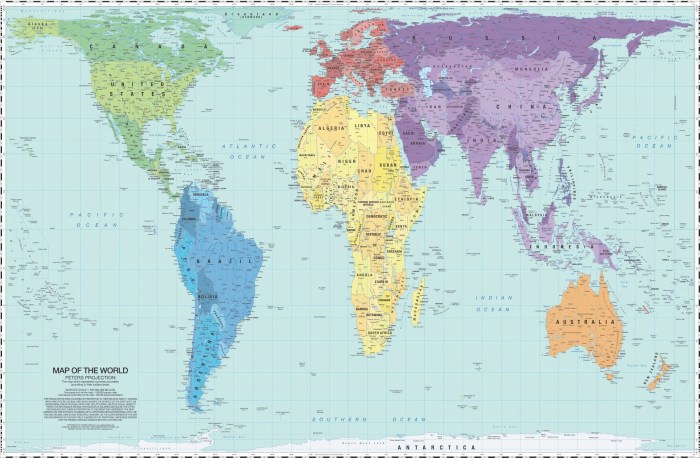
The Gall-Peters projection, also known as the Peters projection, is a map projection developed by German historian and cartographer Arno Peters in 1973. It is a cylindrical equal-area projection, meaning that it preserves the correct proportions of landmasses while distorting their shapes.
The Gall-Peters projection was created as a response to the Mercator projection, which was developed in the 16th century and is still widely used today. The Mercator projection is a conformal projection, which means that it preserves the correct shapes of landmasses while distorting their sizes.
This distortion is most pronounced at high latitudes, where Greenland and Antarctica appear much larger than they actually are.
The Gall-Peters projection was designed to address the perceived Eurocentrism of the Mercator projection. Peters argued that the Mercator projection exaggerated the size of Europe and North America, while diminishing the size of Africa and South America. He believed that this distortion gave a false impression of the world and contributed to the dominance of Western culture.
Pros of the Gall Peters Projection
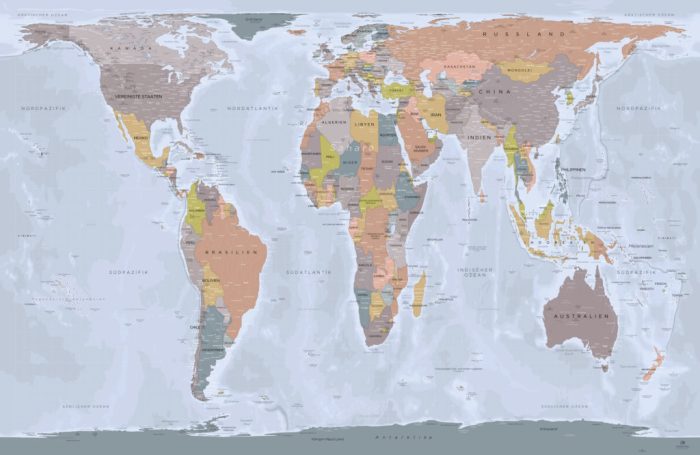
The Gall-Peters projection, also known as the Peters projection, is a rectangular map projection developed by German historian Arno Peters in 1973. It is designed to accurately represent the relative sizes of landmasses, unlike the more commonly used Mercator projection, which distorts landmasses near the poles.
Accuracy in Representing Landmasses’ Relative Sizes, Gall peters projection pros and cons
The Gall-Peters projection uses an equal-area cylindrical projection, which means that it preserves the correct proportions of landmasses on the map. This is in contrast to the Mercator projection, which exaggerates the size of landmasses near the poles, making them appear larger than they actually are.
For example, on the Mercator projection, Greenland appears to be larger than Africa, while in reality, Africa is more than 14 times larger than Greenland.
Advantages in Education and Global Awareness
The Gall-Peters projection is particularly useful for educational purposes because it provides a more accurate representation of the world. This can help students to develop a better understanding of the relative sizes and locations of different countries and continents. Additionally, the projection can promote global awareness by showing the interconnectedness of different regions of the world.
Promoting a More Equitable Representation of the World
The Gall-Peters projection has been criticized for its distortion of shapes, but its proponents argue that this is a necessary compromise in order to achieve a more equitable representation of the world. The Mercator projection, which is still widely used today, was developed in the 16th century for navigation purposes.
It is designed to preserve the correct shape of coastlines, but this comes at the expense of distorting the size of landmasses. The Gall-Peters projection, on the other hand, sacrifices shape accuracy in order to provide a more accurate representation of the relative sizes of different regions of the world.
Cons of the Gall Peters Projection
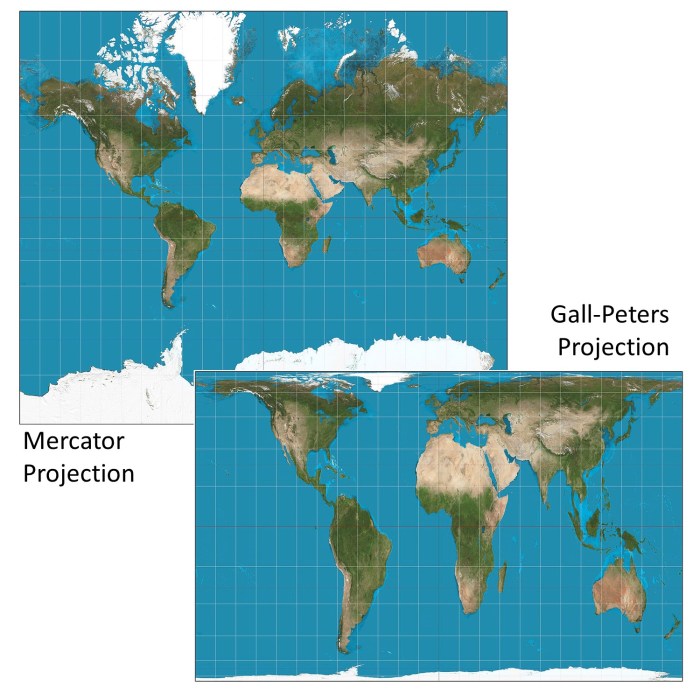
The Gall Peters projection has certain limitations and drawbacks that may hinder its applicability in specific contexts. Despite its strengths in representing the relative sizes of landmasses accurately, it exhibits distortions in shapes and distances, which can be problematic for certain applications.
Distortions in Shapes and Distances
One of the main criticisms of the Gall Peters projection is its distortion of shapes and distances. Unlike conformal projections, which preserve local shapes and angles, the Gall Peters projection stretches landmasses near the poles, resulting in exaggerated shapes and inaccurate representations of their true proportions.
This distortion can be particularly noticeable in polar regions, where landmasses appear elongated and distorted.
Additionally, the Gall Peters projection does not preserve distances accurately. Distances along the equator are correct, but distances along meridians and parallels are distorted. This can lead to incorrect measurements and inaccurate navigation, making the projection less suitable for applications that require precise measurements or distance calculations.
Limitations in Navigation and Mapping
The distortions inherent in the Gall Peters projection limit its usefulness in navigation and mapping applications. The inaccurate shapes and distances can lead to errors in navigation, particularly in polar regions where distortions are more pronounced. For these reasons, the Gall Peters projection is not commonly used for navigation or detailed mapping purposes.
Suitability for Specific Applications
While the Gall Peters projection has certain advantages in representing the relative sizes of landmasses, its limitations in shape and distance accuracy make it less suitable for applications that require precise measurements or accurate navigation. For these applications, conformal projections, such as the Mercator or Lambert conformal conic projections, are more appropriate choices.
Comparison to Other Projections: Gall Peters Projection Pros And Cons

The Gall Peters projection differs significantly from other common projections, particularly in terms of its approach to preserving landmasses’ relative sizes. To facilitate a comprehensive comparison, we present a tabular overview highlighting the key distinctions between the Gall Peters projection and two widely used alternatives: the Mercator and Robinson projections.
The table below compares the Gall Peters projection with the Mercator and Robinson projections based on accuracy, distortion, and suitability for different purposes.
| Projection | Accuracy | Distortion | Suitability |
|---|---|---|---|
| Gall Peters | Preserves the relative sizes of landmasses | Distorts shapes and distances, especially near the poles | Thematic mapping, visualizing global patterns |
| Mercator | Accurate for navigation and distance measurement | Greatly distorts landmasses near the poles | Navigation, nautical charts |
| Robinson | Compromise between Gall Peters and Mercator | Less distortion than Mercator, but still distorts shapes and sizes | General-purpose world maps |
Examples:
- The Gall Peters projection accurately represents the relative sizes of continents, making it suitable for visualizing global patterns of population distribution or resource allocation.
- The Mercator projection is commonly used in navigation due to its accurate representation of distances and angles, but it distorts landmasses near the poles, making it less suitable for thematic mapping.
- The Robinson projection attempts to strike a balance between the Gall Peters and Mercator projections, resulting in less distortion than the Mercator projection while maintaining a reasonable representation of landmass sizes.
Applications of the Gall Peters Projection
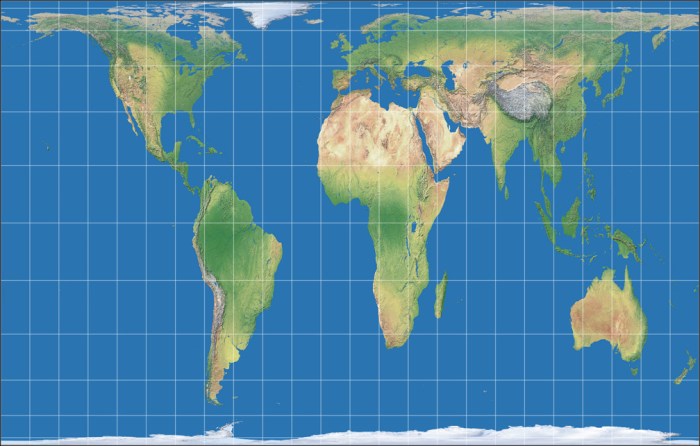
The Gall Peters projection has various applications in education, research, and activism. It serves as a valuable tool for promoting a more accurate understanding of global geography and raising awareness about global issues.
In education, the Gall Peters projection is used to teach students about the true shapes and sizes of continents and countries. It helps them develop a better understanding of the world’s geography and the relationships between different regions.
Research
Researchers use the Gall Peters projection to analyze global data and identify patterns and trends. It allows them to visualize and compare data from different regions of the world without the distortions introduced by other projections.
Activism
Activists use the Gall Peters projection to raise awareness about global issues such as poverty, inequality, and environmental degradation. It helps them to illustrate the disparities between different regions of the world and to advocate for change.
Design Considerations
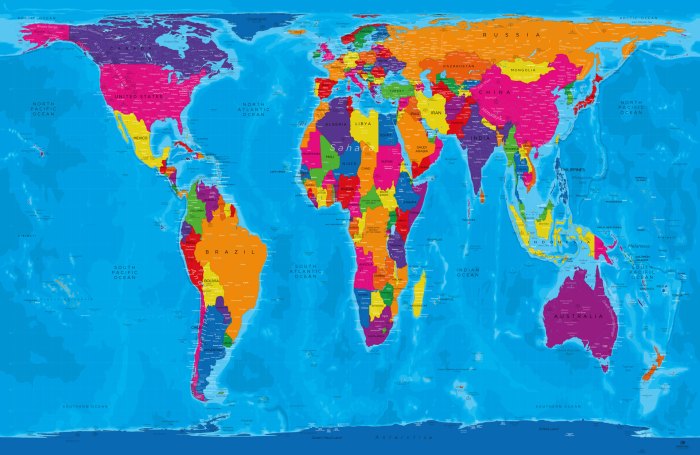
The Gall Peters projection has specific design considerations for effective use in cartography. Understanding these guidelines ensures accurate representation and minimizes distortions.
When selecting the Gall Peters projection, consider the following factors:
Map Purpose and Scale
The projection is best suited for world maps and large-scale regional maps where preserving landmass shapes is crucial. However, it is not ideal for small-scale maps or navigation purposes due to its significant distortions at higher latitudes.
Distortion Minimization
To minimize distortions, center the map on the equator or a specific latitude of interest. This reduces the distortion of landmasses near the poles. Additionally, consider using a graticule (grid lines) to provide accurate distance and direction measurements.
FAQ Insights
What is the main advantage of the Gall Peters projection?
The Gall Peters projection accurately represents the relative sizes of landmasses, making it a valuable tool for education and global awareness.
What are the disadvantages of the Gall Peters projection?
The Gall Peters projection introduces distortions in shapes and distances, making it less suitable for navigation and certain mapping applications.
How is the Gall Peters projection used in practice?
The Gall Peters projection is used in educational materials, research, and activism to promote a more accurate understanding of global geography and raise awareness about global issues.